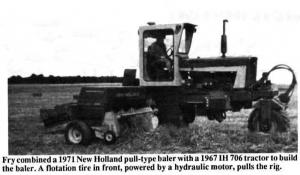1990 - Volume #14, Issue #4, Page #04
[ Sample Stories From This Issue | List of All Stories In This Issue | Print this story
| Read this issue]
Self propelled baler great for small fields
 |
A flotation tire in front, powered by a hydraulic motor, pulls the rig. A variable speed hydrostatic pump allows speeds up to 13 mph forward and reverse.
"It works especially well in small odd-shaped fields with lots of short windrows because it's only half as long as a baler and tractor combination," says Fry. "I can turn short and bale the next windrow immediĦately. I had been using a pull-type baler which was hard to pull around corners. Eventually I tore off the baler's pto shaft. My self-propelled baler has no universal joints which eliminates any worry about driveline trouble. With hydrostatic drive I can vary the speed according to windrow width to keep the baler full all the time. The hydraulic motor is extremely quiet. It's also a lot nicer to drive because the operator sits right alongside the baler. I can see the wind-row without constantly turning around."
Fry removed the baler's pto shaft and tongue and stripped the tractor of every-thing but the engine, frame, and steering column. He used 1/4 in. teel plate to build a box frame that he welded to the side of the bale chamber and to the tractor to connect the two rigs together and to support their weight. The box frame is strengthened by a length of 12-in. channel iron welded to both sides of the tractor frame. Both of the baler's original wheels were left intact. "The weight of the engine is on the tractor's front wheel, and there's no transmission so there's not that much weight on the box frame," notes Fry. The baler's flywheel is powered by a jackshaft that comes directly off the engine. The flywheel is engaged by V-belts con-trolled by the tractor clutch. Fry can use either the foot or hand clutch. Since the engine runs counterclockwise and the fly-wheel clockwise, he had to reverse direcĦtion of the jackshaft using pulleys and an idler.
A hydrostatic pump driven by the engine's crankshaft powers a hydraulic wheel motor mounted on the 30 by 24 flotation tire. The wheel is mounted on a frame made from 12-in. channel iron that's welded to the front fork of the tractor. Fry geared down the hydraulic motor, which he removed from a combine. A small sprocket on the motor chain drives a large sprocket on the hub of the front wheel.
Fry used 1/8-in. steel plate to build a cab for the tractor, fitting it with windows from an International 715 combine cab.
The rig cost $7,500 to build.
Contact: FARM SHOW Followup, Fry Bros., Rt. 2, Box 409, Montpelier, Ohio 43543 (ph 419 485-4002).

Click here to download page story appeared in.

Click here to read entire issue
To read the rest of this story, download this issue below or click here to register with your account number.




